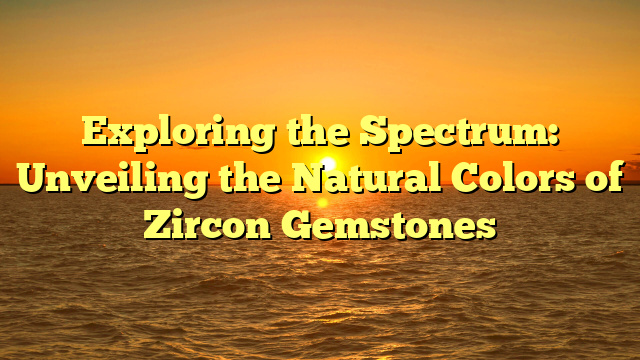Exploring the Spectrum: Unveiling the Natural Colors of Zircon Gemstones
Exploring the Spectrum: Unveiling the Natural Colors of Zircon Gemstones
Zircon is a captivating gemstone that boasts a wide array of colors. This diversity makes it a favorite among gem enthusiasts and collectors. In this article, we delve into the natural colors of Zircon, exploring the factors that contribute to its vibrant spectrum and how these colors are classified.
The Natural Color Spectrum of Zircon
Zircon is known for its brilliant luster and exceptional fire, but it’s the gemstone’s color diversity that truly sets it apart. The colors of Zircon range from colorless to deep hues of blue, green, yellow, orange, brown, and red. This variety is due to the presence of certain trace elements within the crystal structure, which alter its color.
Understanding Color Variations
The color of Zircon can be attributed to the presence of trace elements such as uranium, thorium, and iron. These elements replace zirconium in the crystal lattice, causing variations in color. Additionally, natural radiation over time can alter the structure of the crystal, further influencing the color.
Common Colors of Zircon
- Blue Zircon: One of the most sought-after colors, often achieved through heat treatment of brown or colorless stones.
- Red Zircon: A rare and coveted color, typically found in smaller sizes.
- Yellow Zircon: Offers a range from pastel to golden hues, often mistaken for yellow sapphire.
- Green Zircon: Extremely rare, usually a result of natural radiation damage.
- Colorless Zircon: Known for its brilliance and fire, often used as a diamond substitute.
Factors Influencing Zircon’s Color
The color of Zircon is influenced by several factors, including trace elements, radiation, and even the conditions under which it forms. Here’s a closer look at these factors:
Trace Elements
As mentioned, trace elements such as uranium and thorium can replace zirconium in the crystal structure, affecting the color. The specific type and amount of trace element present can result in a wide range of colors.
Radiation
Natural radiation over time can alter the crystal structure of Zircon, leading to color changes. This is particularly evident in green Zircons, where radiation damage causes the unique hue.
Heat Treatment
Heat treatment is a common practice to enhance or change the color of Zircon. For example, brown Zircons can be heated to produce the popular blue color. However, this process can sometimes reduce the gemstone’s value if not disclosed.
Classifying Zircon’s Colors
Classifying the colors of Zircon is essential for gemologists and collectors. The classification helps in identifying, valuing, and understanding the gemstone better. Here’s a simple classification based on color:
| Color | Description | Rarity |
|---|---|---|
| Blue | Rich, vibrant hue, often enhanced by heat treatment. | Common |
| Red | Deep, saturated color, highly sought after. | Rare |
| Yellow | Varies from pastel to golden, bright and sunny. | Common |
| Green | Caused by radiation damage, very rare and unique. | Very Rare |
| Colorless | Brilliant and clear, often used as a diamond alternative. | Common |
Conclusion
Zircon’s wide color spectrum is a testament to its beauty and versatility as a gemstone. From the fiery reds to the serene blues, each color of Zircon has its own story, influenced by the earth’s elements and conditions. Understanding the factors that contribute to Zircon’s color can enhance our appreciation for this remarkable gemstone. Whether you’re a collector, a gemologist, or simply someone who admires the beauty of natural gemstones, Zircon offers a palette of colors to explore and enjoy.

